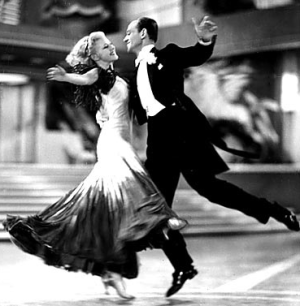It’s no secret that the Hollywood Comet loves musicals.
In 2010, I revealed I had seen 400 movie musicals over the course of eight years. Now that number is over 500. To celebrate and share this musical love, here is my weekly feature about musicals.
 This week’s musical:
This week’s musical:
“The Gay Divorcee” (1934)– Musical #121
Studio:
RKO Radio Pictures
Director:
Mark Sandrich
Starring:
Ginger Rogers, Fred Astaire, Alice Brady, Edward Everett Horton, Eric Blore, Erik Rhodes, William Austin, Betty Grable, Lillian Miles
Plot:
Mimi (Rogers) is traveling with her Aunt Hortense (Brady) and is looking for a
Trivia:
-This was Fred Astaire and Ginger Rogers’ second film together (out of 10 films). Following their success in “Flying Down to Rio” (1933), RKO teamed them together again.
-“The Continental” lasts 17.5 minutes. This was the longest musical number until Gene Kelly’s ballet in “An American In Paris” (1951).
-The Academy Awards for 1934 were the first to include the category for Best Original Song. Con Conrad and Herb Magidson were the first to receive this award for “The Continental.”
-Based on the 1932 Broadway show “The Gay Divorce,” which starred Fred Astaire and Claire Luce. For the film, the title was changed to “Divorcee.” Fred Astaire’s autobiography “Steps in Time” says the change was to show that the film was about the amorous adventures of a woman.
-Costumes designed by Walter Plunkett
Awards and Nominations:
-Won the Academy Award for Best Music, Original Song for the song “The Continental” written by Con Conrad (music) and Herb Magidson (lyrics)
-Nominated for the Academy Award for Best Picture
-Nominated for Best Art Direction by Van Nest Polglase and Carroll Clark
-Nominated for Best Sound, Recording by Carl Dreher (sound director)
-Nominated for Best Music, Score Max Steiner (head of department). Score by Kenneth S. Webb and Samuel Hoffenstein.
Academy Award winning Continental with singing:
Highlights:
-The Continental performance
-Betty Grable’s performance in “Let’s Knock Knees”
Continental danced:
Notable Songs:
-“Night and Day” performed by Fred Astaire
-“Let’s Knock Knees” performed by Betty Grable
-“The Continental” performed by an ensemble, including Erik Rhodes and Lillian Miles
-“Don’t Let It Bother You” performed by Fred Astaire
-“A Needle In a Haystack” performed by Fred Astaire
My review:
“The Gay Divorcee” is probably my favorite Fred Astaire and Ginger Rogers.
Coming fresh from “Flying Down to Rio” (1933), where they play supporting roles to Dolores Del Rio and Gene Raymond, this is their first pairing as leads in a film. I think this introductory film is partially why it’s so good. They feel fresh in their first leading screen team roles, and the plot is funny and entertaining.
In regards to film history, “The Gay Divorcee” is a landmark, as it was the first film to win the Academy Award for Best Song, which went to “The Continental.”
That being said, I may lose all credibility as a musical lover for saying this: As far as musicals go, the Fred Astaire and Ginger Rogers films aren’t terribly high on my list. That’s because of their 10 films together, about half of them are incredibly similar in plot (the different ones being: Flying Down to Rio, Roberta, The Story of Vernon and Irene Castle, The Barkleys of Broadway).
Each plot is boy meets girl, girl doesn’t like boy, girl starts to like boy after they dance, boy loses girl, boy and girl end up together. And while “Gay Divorcee” is similar to this formula, it still feels different and is entertaining.
“The Gay Divorcee” is also fun because along with Astaire and Rogers, we have some other individuals who hop in and sing a song. For example, Betty Grable’s “Let’s Knock Knees” with Edward Everett Horton (in sock and sandals) is hilarious and adorable. In the largest number of the film, “The Continental,” Rogers and Astaire only dance and only sing briefly. That is left to the ensemble, Erik Rhodes and Lillian Miles.
The difference with this plot is that Ginger Rogers is also married to someone else (the whole plot is about her trying to get a divorce), making the film rather Pre-Code.
Now don’t get me wrong, I don’t dislike the Fred Astaire and Ginger Rogers films. They just don’t rank as high as others for me. I think knowing that Astaire and Rogers didn’t love working together (per Rogers’ autobiography) adds to that. Astaire even came to Hollywood hoping to be a solo dancer after performing with his sister for years, and then stars with Ginger from 1933 to 1939 (and then again in 1949 after a long hiatus).
However, as a lover of dance they are terribly fun to watch. Fred and Ginger fans would enjoy this film regardless. But I suggest it since this is one of my favorite Fred and Ginger films (with Roberta).
Check out the Comet Over Hollywood Facebook page, follow on Twitter at @HollywoodComet or e-mail at cometoverhollywood@gmail.com

